The Yoga Stick Pose
Master Class with Ganga White
From Yoga Journal, June, 2008
Written by Mark Schlenz
Balance your internal energy with five variations of Dandasana.
Dandasana appears to be simple, but inside the pose is an intense dance of internal energy.
Ganga White describes asana as a dance of energy. In White’s view, it is not only how far you move into a given asana that matters, but also how you engage with your subtle, or energy body. “Every posture has important principles of structure, alignment, and kinesiology, but learning to cultivate internal energy flow is just as important as mastering these mechanical aspects.” Energy is always moving through the body, but White believes that when you bring your awareness to it, you enhance the flow. When energy is activated this way, it articulates the muscles and bones, thereby helping you refine your alignment in a pose. (The opposite works, too: When you refine your alignment, you enhance the energy flow in a pose.) Working this way White says, “deepens your practice and expands awareness beyond external forms as you focus your attention on the quality and nature of the energy in postures.” It also quiets the mind, calms the nerves, and allays your ego from its tendency to want to improve, change, or fix your poses.
To get in touch with your subtle body, White recommends incorporating two “powers of mind”—concentration and attention. Concentration moves awareness to specific parts of the body, while attention involves spreading awareness to all parts of the body simultaneously. “By strengthening and integrating these powers of mind,” he says, “You can strengthen respiratory and circulatory energy flows and make them more dynamic and you can increase energy currents through the nerves, connective tissues, and muscles to increase sensation, activation, and healing qualities.” And, he explains, “You can experience a sense of mental well being as you become more aware of pranic energy flowing throughout the body.”
Dandasana (Four Limbed Staff Pose), or the Seated Stick Pose, is truly a Mahasana (Great Pose) for cultivating awareness of flowing energies. It appears entirely inactive, but Dandasana involves a dynamic internal energy dance that benefits for yoga practitioners of all levels. Even its simplest version activates every energy line required for the posture’s most challenging expression. In Dandasana, energy flows up and down along the entire circumference of the spine (the sides, the front, and the back) between your point of contact with the earth and the skyward extension of your head. At the same time, energy extends evenly from the inner and outer thighs to both edges of the feet, through the backs of your legs into the floor, and along the tops of the legs into the ankles.
Keeping track of your breath, alignment, energy, and awareness is challenging at first. The really tricky part, though, is to integrate concentration and attention. In his book, Yoga Beyond Belief: Insights to Awaken and Deepen Your Practice, White says that “Concentration by its very nature moves from point to point and when you focus on one point you may lose awareness of another.” Focusing on your abdomen in Seated Stick Pose, for instance, may cause you to neglect the edges of your feet, or concentrating on the crown of the head may draw attention away from lengthening the arms.
While you are concentrating on the different components of your pose, you must also keep your attention on the whole. Attention to the whole does not negate the need for focused concentration. And, as White is quick to note, too much focus on “attention” by itself becomes a kind of concentration. However, when you are able to balance concentration and awareness in Seated Stick Pose, you will enhance your awareness of all these energy flows while keeping the body stable, firm, and light in energized stillness.
Dandasana may look simple, but it develops foundational alignments and core abdominal actions for numerous seated poses and serves as a neutral grounding during pose seated vinyasa flows sequences. Once you can integrate concentration and attention to activate energy lines in Seated Stick Pose, deepen your experience by bringing awareness to the bandhas, or locks. Integrating Mula Bandha (Root Lock), Uddiyana Bandha (Flying Up Lock), and Jalandhara Bandha (Chin Lock) to create Maha Bandha (Great Lock). (If you need guidance on how to do these, please visit our website, yogajournal.com) Here, in energized stillness, your asana will merge with Pranayama (Breathing Techniques) and you will cultivate awareness that will bring more dynamic versions of the posture within reach. By integrating your experiences in various versions of Dandasana, you will someday naturally to rise into Utpluti Dandasana—or Floating Stick Pose.
Dandasana (Four Limbed Staff or Seated Stick Pose)
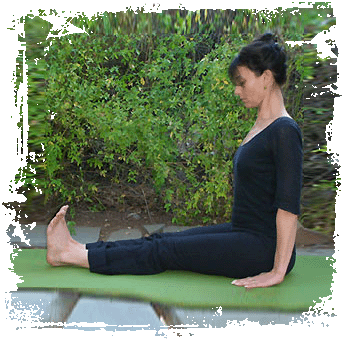 All of the poses in this sequence begin and end with Seated Stick Pose. Once you become comfortable and energized holding the basic pose, you will strengthen your power of attention and absorb the energy of the variations that follow by returning to this pose between each one. Initially five or six breaths in the pose may be enough to reveal its deceptive energetic power; eventually you may learn to enjoy longer holds up to 10 or 15 breaths.
All of the poses in this sequence begin and end with Seated Stick Pose. Once you become comfortable and energized holding the basic pose, you will strengthen your power of attention and absorb the energy of the variations that follow by returning to this pose between each one. Initially five or six breaths in the pose may be enough to reveal its deceptive energetic power; eventually you may learn to enjoy longer holds up to 10 or 15 breaths.
To come into the pose, sit with your legs extended and your back tall and straight. Lengthen your spine and press your hands into the ground next to your hips without lifting your sitting bones off the floor. Bend elbows or come to your fingertips to adjust for the proportions in arms and torso. Drop your chin so that it is about level with the ground. Notice the different lines of energy in this simple shape. Extending energy runs from shoulders down the arms and into the earth. Lifting energy rises from the pelvic floor all the way up the front of the spine. At the same time, extend energy lines along both sides of each leg.
With flexed ankles, spread and create space between your toes. Observe how these movements in the feet activate more nerve channels through the legs. Notice a flow sensation awakening in the arches of the feet and through the joints of every toe. Create energetic connections with the floor through the backs of your thighs and calves to increase extension of the legs; feel your heels rise. Maintain these activations as you also generate lifting energy in the spine and extend through the crown of the head. Simultaneously lift the spine and chest, drop the chin, lengthen the arms, and firm the abdomen. Activate energy evenly through the arches and outer edges of each foot, as though pressing against a wall, to ensure energy flows evenly through both legs and throughout the entire body.
As you expand your attention to all these activations at once with awareness of their inner-workings, you will experience the posture fully. Observe the interplays throughout your body. Notice how engaging the abdominal muscles and lengthening the muscles along the spine create compatible counter-movements of through the legs. Notice how lifting the chest upward balances the downward counter-movements of the tailbone and sitting bones.
Spend a few breaths awakening each bandha to bring strength and lightness to your pose. As you inhale and exhale for a few breaths, energetically connect your sitting bones to each other and to the mat, which will naturally encourage the pelvic floor to lift into Mula Bandha. Release it and then firm the lowest part of your belly toward the spine gently with each exhalation and feel Uddiyana Bandha engage. Release that and then feel the next inhalation lift the breastbone and elongate the spine through the back of the neck as your chin draws toward the breastbone into Jalandara Bandha. After you’ve focused energy in each bandha a few breaths, do them again individually in the same order for one breath, then do Maha Bandha by doing them all at the same time. If you are familiar with retaining the breath, you can do that, too. Either way, simply sitting with Maha Bandha in Dandasana cultivates your ability to become powerfully absorbed in balancing rising and falling energies of your breath, extending energies in the body, and the earth’s gravitational pull.
Parivrtta Dandasana (Revolved Four Limbed Staff or Twisting Seated Stick Pose)
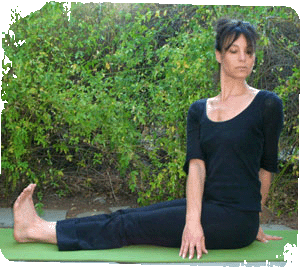 Twisting Stick Pose teaches you to keep your attention on extending evenly aligned energy flows through the inner and outer lines of the legs while you concentrate on turning the spine. It also opens the outer hips, preparing them for the later poses.
Twisting Stick Pose teaches you to keep your attention on extending evenly aligned energy flows through the inner and outer lines of the legs while you concentrate on turning the spine. It also opens the outer hips, preparing them for the later poses.
To transition from Seated Stick Pose to the Twisting version, raise your arms straight up. When you bring your arms overhead you’ll notice an additional challenge—your spine no longer has support from the hands contacting the floor. To balance this, lengthen the spine with a firm counter-movement through your base to increase your physical and energetic connection with the earth. Extend your arms overhead, palms facing each other, and bring your arms alongside the ears in alignment with the shoulders to create more lifting energy. Counter that by sending energy from your sitting bones to your fingertips and from your fingertips back down to the earth to open and stabilize the shoulders with a relaxed neck. Lift your floating ribs away from the pelvic girdle with an inhalation to prepare space for the spine to rotate.
Maintain extending energies throughout the body, but relax the chin as you begin the twist with exhalation. Turn through the waist while extending the legs and pulling the feet and toes back. Lift the chest to create space between lumbar vertebrae. Bring your right hand to the ground behind the right hip, pointing fingers toward the right. Reach your left hand across your legs to the floor alongside the right thigh. If you have short arms and are not able to get your palms to the ground, press through the fingertips instead.
Once you’re in the external shape of the pose, bring awareness to its internal energies. Observe how the energy flowing through your spine and legs inspires increases your ability to turn the spine. But be sure not to concentrate only on turning, twisting, or stretching along outer portions of the body: instead, bring attention to your breath, too. As you inhale, engage the bandhas to support spinal extension; as you exhale, allow rotation to come from the core of the body and from a sense of relaxation in the spine.
After four or five breaths in the twist, transition to the other side by extending and pressing through feet and legs as you inhale the arms back up overhead. Then bring your hands alongside your hips in Seated Stick Pose once more. Stay for several cycles of breath, rebalancing your energy. Observe and absorb the effects of the twist throughout your entire body. Notice any improvements in the quality of the energy flow. Sense your spinal discs expanding and drawing sustenance from surrounding tissue. Then lift your arms up with an inhalation and exhale as you transition to the other side.
Purvottanasana (Upward Plank or Reverse Stick Pose)
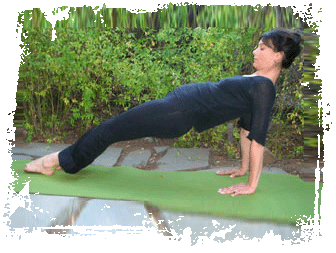 Start in Dandasana and activate the energy lines in your spine and legs. For this pose, try feeling your abdomen as a point of concentration in the field of energy lines you create. Increase energy flows everywhere with integrated attention as you inhale the spine its full extension. Use Jalandara Bandha to enhance extension and protect your neck. Next, extend through your arms and lift your chest as you slide your hands back a few inches behind the hips with fingers pointing forward.
Start in Dandasana and activate the energy lines in your spine and legs. For this pose, try feeling your abdomen as a point of concentration in the field of energy lines you create. Increase energy flows everywhere with integrated attention as you inhale the spine its full extension. Use Jalandara Bandha to enhance extension and protect your neck. Next, extend through your arms and lift your chest as you slide your hands back a few inches behind the hips with fingers pointing forward.
Balance the energy moving up through the spine and crown of the head with equal energy moving through your legs and feet toward the floor as you lift your hips upward to the ceiling. Even if the entire soles of your feet do not actually contact your mat, you still want to expand energetically through the arches, metatarsals, and toes as though they were. It’s not the floor, but the energy flow that matters here.
As you concentrate flowing energy from the toes to the top of the head, maintain your awareness of the interactions that integrate the front and back of your body. Broaden the sacrum and tuck the tailbone toward the heels to create a supportive feeling from the backside of the body. At the same time, open and expand across the breastbone and collarbones. Watch how energy from underneath the body comes into interplay with the head-to-toe energy line of the pose.
If you do reach your head back, be sure not to cause tension in the neck. Keep it in line with the dpinr and use the crown of the head as a concentration point for extending energy. White has noticed, “as you get older, arching your head back tends not to feel good and can even aggravate the cervical spine.” And, he says, “younger people tend to lead too much with the head in backbends.”
Just a few breaths in this pose requires a lot of energy: Hold it only as long as you can maintain your attention. When you leave the Reversed Stick Pose, stay physically and mentally engaged and do not collapse with your weight pulling through your buttocks. Think of your departure from the raised position as an energetic return to Seated Stick Pose. Become aware of a continuum of movements and counter-movements of the muscles and the breath as you transition into and out of these poses. Let your attention become absorbed in continuity, balancing firmness and lightness within and between your postures by repeating it a few times. Always reintegrate your experience by sitting in Dandasana for several breaths in between poses.
Ubhaya Padangusthasana (TK YJ translation or Balancing Stick Pose)
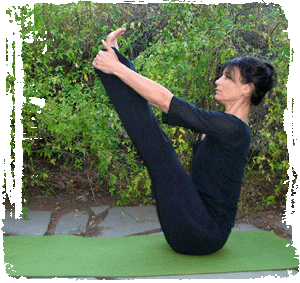 With practice, Balancing Stick Pose will increase your ability to create mutually supportive lines of energy because it requires you to balance your energy in the legs and spine. Lifting into this more challenging version of Dandasana will also increase your awareness of the interactions between the body’s energy and earth’s gravitational pull, will require even more concentration and attention.
With practice, Balancing Stick Pose will increase your ability to create mutually supportive lines of energy because it requires you to balance your energy in the legs and spine. Lifting into this more challenging version of Dandasana will also increase your awareness of the interactions between the body’s energy and earth’s gravitational pull, will require even more concentration and attention.
Again, start in Dandasana. Imagine your core as a point of concentration and allow the energy to flow from your center to every point of your body. At the same time, bring greater attention to your contact with the earth, the lifting power of your breath, and integrated activation of the bandhas. Maintain extending energy through the legs even as you bend the knees to take the edges of your feet with your hands. Then keep energy moving evenly from your center through the spine and legs as you inhale to lift the breastbone higher while rocking back into balance on the sitting bones.
Consciously balance the energy flowing from your core through the spine and the legs as you inhale to come into the pose. Notice what happens if the leg and spinal energy lines separate from each other—the legs will move sooner or with more energy than the spine (or vice versa) and you’ll lose contact with your core. To lift the legs, you must extend evenly through the soles of your feet and through the crown of your head—at the same time and to the same degree!
Bring awareness to your breath to fuel your energy lines and to allow the bandhas to engage. Observe the body feeling lighter and more stable in balance as you integrate Maha Bandha. Firm your energetic connection with the earth through each exhalation. Rejuvenate energy flows from your center to your fingers, toes, and crown of the head with each inhalation. Focus your eyes on your spreading toes with a drishti that integrates energetic qualities of both concentration and attention in your gaze as you generate energy in your core.
After four or five breaths, return to Dandasana to integrate your experience in the pose and to prepare for levitating into Floating Stick Pose.
Utpluti Dandasana (Floating Stick Pose)
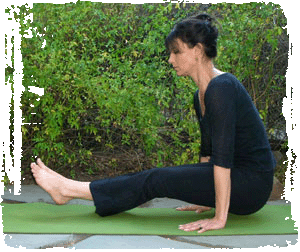 Floating Stick Pose is an energy dance with gravity. When you integrate your experience of the Dandasana variations and learn this dance, you learn more about yourself and about the earth as your partner. Where Seated Stick Pose seems deceptively inactive from an external view, Utpluti Dandasana may appear more difficult than it actually is. To prepare, sustain practice of Seated Stick Pose over time with deeper absorption of concentration and attention in awareness of breathing, balance, activation, and alignment. Practice raising and lowering yourself during a single cycle of breath to develop strength and awareness together gradually before you attempt to do longer holds while lifted.
Floating Stick Pose is an energy dance with gravity. When you integrate your experience of the Dandasana variations and learn this dance, you learn more about yourself and about the earth as your partner. Where Seated Stick Pose seems deceptively inactive from an external view, Utpluti Dandasana may appear more difficult than it actually is. To prepare, sustain practice of Seated Stick Pose over time with deeper absorption of concentration and attention in awareness of breathing, balance, activation, and alignment. Practice raising and lowering yourself during a single cycle of breath to develop strength and awareness together gradually before you attempt to do longer holds while lifted.
Floating Stick Pose requires core and arm strength, but the real key to floating above the earth involves unlocking energy flows through the feet, legs, and spine. Neither concentrated efforts to press with sheer arm strength, nor to pull up through abdominal muscles, will bring you into an energetic dance with the earth that allows you to float lightly from its gravitational pull. Instead, you will levitate into Floating Stick Pose by totaling energizing your body into a firm and light stability and then elegantly counterbalancing its weight centers through breath-inspired counter-movements.
At first you may only feel your skeletal structure lifting slightly, though no part of your flesh actually leaves the floor. Do not rush to push through this experience; instead, absorb its levitating qualities over several practice sessions. Keep lengthening your arms and increase space between your floating ribs and the pelvis. Eventually, the sitting bones may rise and begin to swing back through balance behind the wrists without observable exertion on your part.
Although you may bend the knees a bit as your hips float up, keep your feet activated and resist urges to lift the legs from the floor with muscular action. Keep your attention instead on overall lightness, stability, and balance while your calves or heels still touch the ground. Increase core integration through extension of the spine and legs. Though it may seem counterintuitive, sense energetic connection with the earth through the sitting bones, the backs of the calves, and the thighs even as they begin to levitate. With some practice, your heels will eventually allow themselves to be pulled back and up away from the floor by swinging momentum of the hips. When this happens, reach the arms down and breathe into the breastbone to encourage it to lift.
Remember that gasping or tightening the breath will interrupt flowing and fragment concentration and attention. Allow uninterrupted breath to bring your awareness to energy flows and points of concentration along all dimensions of the spine, legs, and arms. Let attention expand to the interplays of between the breath and the bandhas while your energy body dances through balance with the earth.
By practicing this sequence you can begin to follow your internal awareness to guide and inspire their practice instead of relying only on external feedback or information. He believes that Seated Stick Pose provides an opportunity to integrate expanding awareness of internal energies in stillness to inspire natural, intelligent action. He illustrates this lesson by comparing it to a spring-fed stream flowing through a deep canyon. Threading boulders in tumbling cascades, the stream carries a stick steadily downstream; yet, within quiet pools, energies spiral in powerful eddies, spinning the floating stick in circles as it dances upstream once more.
Dandasana (Seated Stick Pose)
Connect firmly with the floor through thighs and calves. Simultaneously lift the spine and chest, drop the chin, extend the arms, and firm the abdomen. Elevate sitting bones with a blanket or use a bolster under the knees if you need to relieve tight hamstrings or tension in the lower back. Allow points of concentration to expand into full body and breath attention as you generate extending energy through the legs and feet. Hold for five to six breaths.
Parivrtta Dandasana (Twisting Stick Pose)
Inhale as you raise arms overhead and lift the rib cage to prepare for twisting. Relax your chin and turn to the right with exhalation. Keep the inner and outer edges of your feet evenly activated to maintain proper alignment of the hips. Bring your right hand behind you and your left hand to your right thigh. Lift energy through your spine and out through your legs as you rotate from the energy point in your abdomen. Hold each side for four or five breaths. Rest for several breaths in Simple Seated Pose between sides.
Purvottanasana (Reverse Stick Pose)
From Seated Stick Pose, move your hands behind your hips and press them firmly into the floor. Arc the whole body up with inhalation. Lengthen the soles of your feet and your toes toward the floor as you rise. If it feels better on your neck, you may drop your chin forward. Integrate energies from the front and back of the body with the head-to-toe energy flow. Start with two or three breaths and slowly build strength for longer holds.
Ubhaya Padangusthasana (Balancing Stick Pose)
Hold your big toes with your first two fingers and thumbs or, if you have the flexibility, wrap your hands around the soles of the feet and interweave your fingers. (At first, you may find holding outer edges of the feet with your hands makes the pose more accessible and helps maintain activation and alignment of the inner arches.) Bend the knees slightly and tilt back onto the sitting bones with an inhalation, staying attentive to the energy in your feet and legs. Keep spreading your toes as you lift and arc the spine while reaching out through your legs. Stay for four or five breaths or for as long as your concentration and attention are evenly balanced.
Utpluti Dandasana (Floating Stick Pose)
After practicing and integrating your experience of the variations described above, sit in Seated Stick Pose to energize your entire body. Visualize yourself floating from the floor for several breaths, but do not initiate an effort through the arms or belly to do so. Instead, when your energy body is ready, coordinate the breath and the bandhas, tilt your pelvis forward and lengthen your spine. From there, inhale as you reach your breastbone forward and exhale as you draw your hips back, allowing the back to round a bit. The momentum of these actions will allow your hips to float behind the wrists. Stay completely activated as you lower back into Seated Stick Pose. Practice rising and lowering gracefully in a single cycle of the breath before attempting longer holds.
Mark Schlenz is a freelance writer who practices, teaches and offers personal yoga coaching from his home in the mountains of the eastern Sierra Nevada.
Ganga White is author of Yoga Beyond Belief—Insights to Awaken and Deepen Your Practice and co-director of White Lotus Yoga Foundation retreat.
